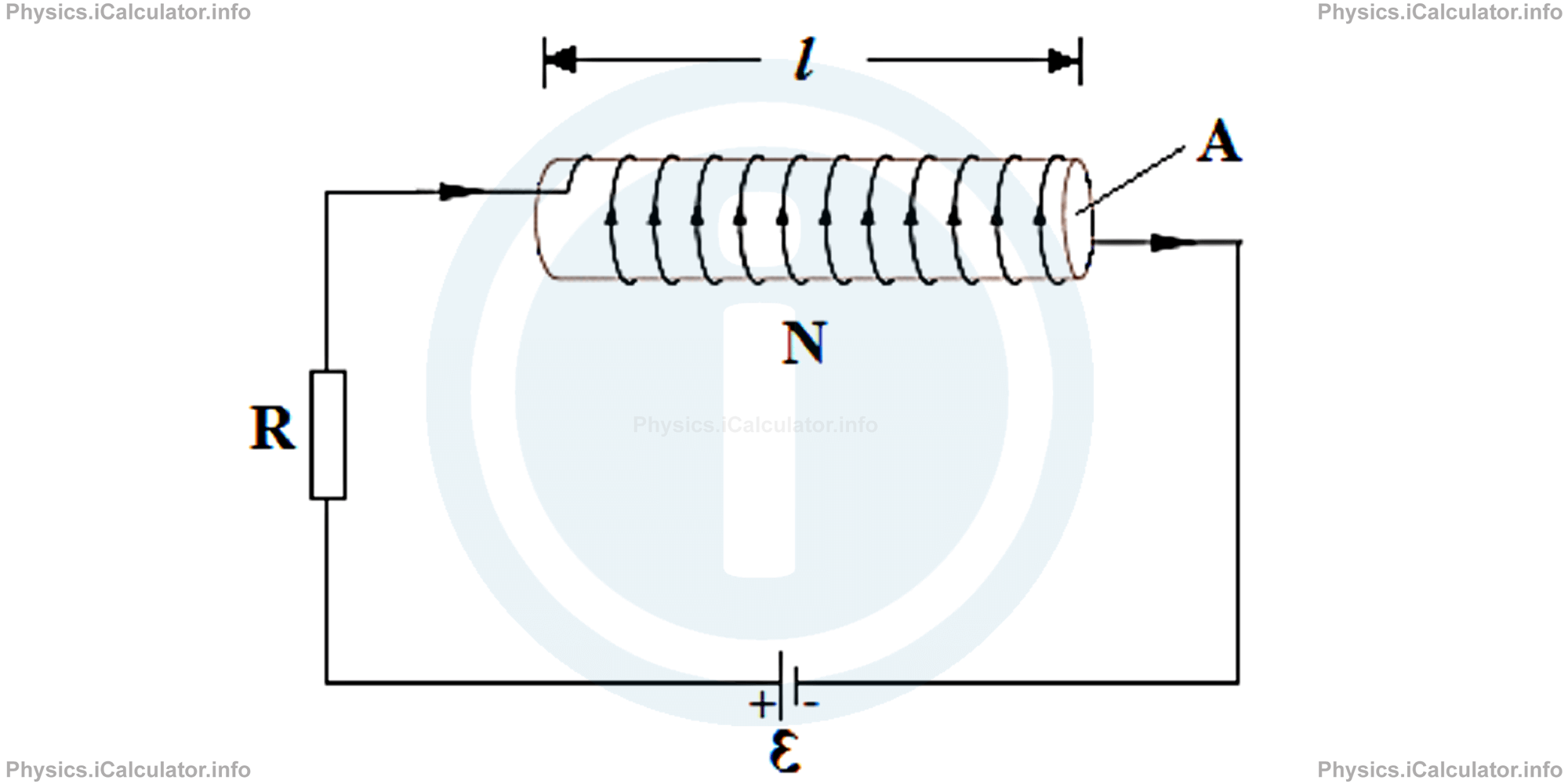Menu
Physics Lesson 16.9.2 - Another Approach on Inductance
Please provide a rating, it takes seconds and helps us to keep this resource free for all to use
Welcome to our Physics lesson on Another Approach on Inductance, this is the second lesson of our suite of physics lessons covering the topic of Inductance and Self-Induction, you can find links to the other lessons within this tutorial and access additional physics learning resources below this lesson.
Another Approach on Inductance
If a current I is flowing through the turns of a solenoid (called henceforth an "inductor"), it produces a magnetic flux Φm through the central region of the inductor. As a result, we obtain for the inductance of inductor in terms of magnetic flux:
where N is the number of turns in the inductor. Indeed, since
and
We obtain by combining the two above formulae (considering also the fact that the magnetic field of a solenoid is B = μ0 ∙ N ∙ I/L)
= N ∙ B ∙ A/I
= N ∙ μ0 ∙ N ∙ I/L ∙ A/I
= μ0 ∙ N2 ∙ A/I
Therefore, the two formulae of inductance given above are equivalent.
Example 2
When a 10 cm long solenoid containing 200 turns and having the cross-sectional area of each turn equal to 4 cm2 is connected to a 24 V power source. The resistance of the circuit is 48 Ω. What is the magnetic field the solenoid generates in such conditions?

Clues:
l = 10 cm = 10-1 m
N = 200 turns = 2 × 102 turns
A = 4 cm2 = 4 × 10-4 m2
ε = 24V
R = 48 Ω
(μ0 = 4π × 10-7 N/A2)
B = ?
Solution 2
First, we calculate the current flowing through the circuit through the Ohm's law. We have
= 24 V/48 Ω
= 0.5 A
Now, let's calculate the inductance in the solenoid. We have
= (4 ∙ 3.14 × 10-7 N/A2 ) ∙ (2 × 102 )2 ∙ (4 × 10-4 m2 )/(10-1 m)
= 2 × 10-4 H
Now, let's use the other formula of inductance to find the magnetic field through the solenoid. Thus, giving that
we obtain
= (0.5 A) ∙ (2 × 10-4 H)/(2 × 102 ) ∙ (4 × 10-4 m2 )
= 1.25 × 10-3 T
= 1.25 mT
You have reached the end of Physics lesson 16.9.2 Another Approach on Inductance. There are 3 lessons in this physics tutorial covering Inductance and Self-Induction, you can access all the lessons from this tutorial below.
More Inductance and Self-Induction Lessons and Learning Resources
Whats next?
Enjoy the "Another Approach on Inductance" physics lesson? People who liked the "Inductance and Self-Induction lesson found the following resources useful:
- Inductance Feedback. Helps other - Leave a rating for this inductance (see below)
- Magnetism Physics tutorial: Inductance and Self-Induction. Read the Inductance and Self-Induction physics tutorial and build your physics knowledge of Magnetism
- Magnetism Revision Notes: Inductance and Self-Induction. Print the notes so you can revise the key points covered in the physics tutorial for Inductance and Self-Induction
- Magnetism Practice Questions: Inductance and Self-Induction. Test and improve your knowledge of Inductance and Self-Induction with example questins and answers
- Check your calculations for Magnetism questions with our excellent Magnetism calculators which contain full equations and calculations clearly displayed line by line. See the Magnetism Calculators by iCalculator™ below.
- Continuing learning magnetism - read our next physics tutorial: Induction and Energy Transfers
Help others Learning Physics just like you
Please provide a rating, it takes seconds and helps us to keep this resource free for all to use
We hope you found this Physics lesson "Inductance and Self-Induction" useful. If you did it would be great if you could spare the time to rate this physics lesson (simply click on the number of stars that match your assessment of this physics learning aide) and/or share on social media, this helps us identify popular tutorials and calculators and expand our free learning resources to support our users around the world have free access to expand their knowledge of physics and other disciplines.
Magnetism Calculators by iCalculator™
- Angular Frequency Of Oscillations In Rlc Circuit Calculator
- Calculating Magnetic Field Using The Amperes Law
- Capacitive Reactance Calculator
- Current In A Rl Circuit Calculator
- Displacement Current Calculator
- Electric Charge Stored In The Capacitor Of A Rlc Circuit In Damped Oscillations Calculator
- Electric Power In A Ac Circuit Calculator
- Energy Decay As A Function Of Time In Damped Oscillations Calculator
- Energy Density Of Magnetic Field Calculator
- Energy In A Lc Circuit Calculator
- Faradays Law Calculator
- Frequency Of Oscillations In A Lc Circuit Calculator
- Impedance Calculator
- Induced Emf As A Motional Emf Calculator
- Inductive Reactance Calculator
- Lorentz Force Calculator
- Magnetic Dipole Moment Calculator
- Magnetic Field At Centre Of A Current Carrying Loop Calculator
- Magnetic Field In Terms Of Electric Field Change Calculator
- Magnetic Field Inside A Long Stretched Current Carrying Wire Calculator
- Magnetic Field Inside A Solenoid Calculator
- Magnetic Field Inside A Toroid Calculator
- Magnetic Field Produced Around A Long Current Carrying Wire
- Magnetic Flux Calculator
- Magnetic Force Acting On A Moving Charge Inside A Uniform Magnetic Field Calculator
- Magnetic Force Between Two Parallel Current Carrying Wires Calculator
- Magnetic Potential Energy Stored In An Inductor Calculator
- Output Current In A Transformer Calculator
- Phase Constant In A Rlc Circuit Calculator
- Power Factor In A Rlc Circuit Calculator
- Power Induced On A Metal Bar Moving Inside A Magnetic Field Due To An Applied Force Calculator
- Radius Of Trajectory And Period Of A Charge Moving Inside A Uniform Magnetic Field Calculator
- Self Induced Emf Calculator
- Self Inductance Calculator
- Torque Produced By A Rectangular Coil Inside A Uniform Magnetic Field Calculator
- Work Done On A Magnetic Dipole Calculator